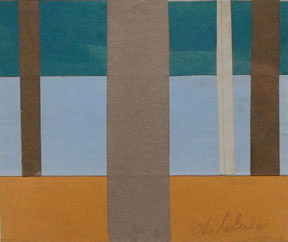Modulating a Maine Modernist
Back in the 1950s, three artists lived in a building on 28th St. in New York City. Bernard “Blackie” Langlais lived and worked on the top floor. Alex Katz had a studio on the second floor. And Charles DuBack lived on the first floor above the street level lumberyard below. All three men attended the […]

Riverside, by Charles DuBack
Back in the 1950s, three artists lived in a building on 28th St. in New York City. Bernard “Blackie” Langlais lived and worked on the top floor. Alex Katz had a studio on the second floor. And Charles DuBack lived on the first floor above the street level lumberyard below. All three men attended the Skowhegan School of Painting & Sculpture and all three became closely associated with Maine art, albeit in decidely different ways.
Blackie Langlais (1921-1977) returned to his native Maine and became revered regionally as a sculptor of whimsical wooden animals. Alex Katz (b. 1927) became a prince of the New York art world and an esteemed summer resident of Maine, internationally famous for his flat, stylish paintings of family and friends. And Charles DuBack (b.1926), moving back and forth between Manhattan and Maine and between representation and abstraction, never really registered on the Maine art scene until fairly recently. While he had a long career in New York in the 20th century, DuBack seems to be making a 21st comeback in Maine.
In 2003, the Center for Maine Contemporary Art in Rockport mounted a DuBack mini-retrospective and he also had exhibitions at Round Top Center for the Arts in Damariscotta and Greenhut Galleries in Portland. Charles DuBack: Coming to Maine at the Portland Museum of Art (through January 3, 2010) and Charles DuBack: Early & Recent Work at the June Fitzpatrick Gallery in Portland (November 4-25) are the latest in a series of exhibitions bringing greater attention to this long overlooked painter.
Charles DuBack: Coming to Maine features both paintings and collages from the late 1950s when DuBack began coming seasonally to Maine and watercolors from 1998, seven years after he moved to Tenants Harbor year-round. Though most of the DuBack paintings I have seen are rather mainstream painterly landscapes, the work in the Portland Museum of Art show evidences the artist’s debt to abstraction and shows his primary impulse as a painter to be reduction, a very modernist inclination. The 1950s pieces tend to reduce imagery to flat, non-overlapping areas of bright color. The 1990s watercolors are much looser, befitting the aqueous medium, but they too prefer discrete forms to integrated ones.
Artists tend to develop what I think of as “visual frequencies,” a high fidelity aesthetic range that is a function of how closely their paintings correspond to perceived realities. Tightly rendered realism is a high-pitched frequency that resonates across a broad spectrum of viewers, from the romantic realism of an Andrew Wyeth to the photorealism of a Chuck Close. Purely abstract art tends to have a low visual frequency to which fewer viewers respond well.
Charles DuBack’s art tends to oscillate at a mid-range visual frequency, pixilating perception now at the high resolution level of representation then at the low-res of abstraction. A lot of good painters work in this range (Milton Avery and Stephen Pace come first to mind), but I have a feeling that DuBack’s modulation back and forth along this visual frequency over a long career has something to do with the fact that his art hasn’t found a wider audience. The Portland Museum of Art and June Fitzpatrick Gallery shows may help. It is usually new work that commands new audiences and June Fitzpatrick reports that Charles DuBack has created several ambitious new paintings, some in excess of seven feet, for his November show.
[Portland Museum of Art, 7 Congress Sqaure, Portland ME, 207-775-6148. June Fitzpatrick Gallery, 522 Congress St., Portland ME, 207-699-5742.]
Edgar Allen Beem
Take a look at art in New England with Edgar Allen Beem. He’s been art critic for the Portland Independent, art critic and feature writer for Maine Times, and now is a freelance writer for Yankee, Down East, Boston Globe Magazine, The Forecaster, and Photo District News. He’s the author of Maine Art Now (1990) and Maine: The Spirit of America (2000).
More by Edgar Allen Beem

